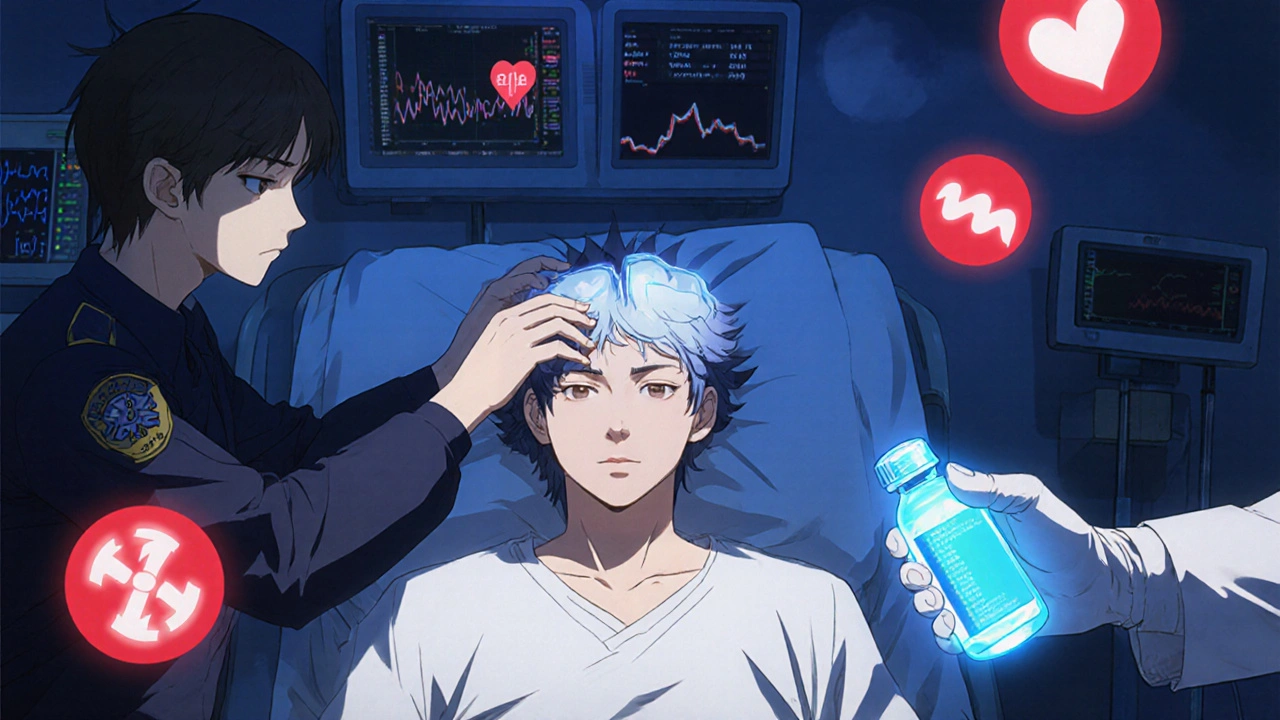Serotonin Syndrome Risk Checker
When you start a new antidepressant or add a painkiller like tramadol to your routine, you might expect mild side effects-nausea, drowsiness, maybe a headache. But what if your body starts shaking uncontrollably, your temperature spikes to 104°F, and you feel like you’re losing your mind? That’s not just a bad reaction. It’s serotonin syndrome, a dangerous and sometimes deadly condition caused by too much serotonin in your brain and nervous system.
What Exactly Is Serotonin Syndrome?
Serotonin syndrome isn’t a disease you catch. It’s a drug reaction. It happens when your body gets flooded with serotonin, a chemical that helps regulate mood, sleep, and muscle control. Normally, your body keeps serotonin levels balanced. But when you mix certain medications-or take too much of one-it can overflow. Think of it like a sink with the faucet on full and the drain clogged. The water rises fast. This isn’t rare. About 8% of all drug reactions reported to poison control centers are serotonin syndrome. And it’s getting more common. Between 2004 and 2017, cases jumped by 250%, mostly because more people are taking antidepressants. In fact, nearly 1 in 5 Americans now takes one. Many don’t realize the risks of combining them with other drugs-even over-the-counter ones.How It Happens: The Top Medications That Cause It
The biggest danger comes from mixing two or more drugs that increase serotonin. The most dangerous combos involve:- MAOIs like phenelzine (Nardil) or tranylcypromine (Parnate)-used for depression or anxiety
- SSRIs like fluoxetine (Prozac), sertraline (Zoloft), or escitalopram (Lexapro)
- SNRIs like venlafaxine (Effexor) or duloxetine (Cymbalta)
- Triptans for migraines, such as sumatriptan (Imitrex)
- Opioids like tramadol (Ultram), fentanyl, or meperidine (Demerol)
- Illicit drugs like MDMA (ecstasy), cocaine, or LSD
The Symptoms: What to Watch For
Serotonin syndrome doesn’t show up the same way in everyone. But there’s a clear pattern. Doctors use the Hunter Serotonin Toxicity Criteria to diagnose it. You need to be taking a serotonergic drug and have at least one of these:- Spontaneous clonus (involuntary muscle jerks)
- Inducible clonus (muscle spasms triggered by moving your ankle) plus agitation or sweating
- Ocular clonus (eyes darting uncontrollably) plus agitation or sweating
- Tremor plus overactive reflexes
- Muscle stiffness plus fever above 100.4°F plus clonus
- Tremors or shaking (often the first sign)
- Agitation, restlessness, or confusion
- Heavy sweating, even when it’s cool
- Rapid heartbeat (over 100 bpm)
- Diarrhea
- Goosebumps
- High fever (over 106°F)
- Seizures
- Unconsciousness
- Difficulty breathing
- High blood pressure that spikes and crashes
- Organ failure

Why It’s Often Misdiagnosed
Serotonin syndrome looks a lot like other serious conditions. That’s why it’s missed so often.- Neuroleptic Malignant Syndrome (NMS) causes muscle stiffness and fever too-but it’s slow to develop, usually from antipsychotics, and lacks tremors or clonus.
- Malignant Hyperthermia happens during anesthesia, not from medications you take at home.
- Anticholinergic toxicity causes dry skin, flushed face, and confusion-but no sweating or tremors.
What to Do in an Emergency
The first step is simple: stop all serotonergic drugs immediately. No exceptions. Even if you think it’s just a mild case, don’t wait. For mild cases-tremors, sweating, agitation-you’ll likely be monitored at home or in an observation unit. Doctors usually give benzodiazepines like lorazepam (Ativan) to calm the nervous system. Symptoms often resolve in 24 to 72 hours. But if you have a fever over 102°F, muscle stiffness, or confusion, you need the hospital. Here’s what happens:- Cooling down: Ice packs, cooling blankets, IV fluids. If your temperature hits 106°F, they may use dantrolene, a muscle relaxant.
- Cyproheptadine (Periactin): This is the only antidote. It blocks serotonin receptors. Doctors give 12 mg right away, then 2 mg every 2 hours as needed-up to 32 mg in 24 hours.
- Supportive care: IV fluids, oxygen, heart monitoring. If you can’t breathe, they’ll intubate you.

How to Prevent It
Prevention is the best defense. Here’s how:- Always tell your doctor about every medication you take-including supplements, OTC painkillers, and herbal products. Many people don’t think St. John’s wort or cold medicine counts.
- Wait 14 days after stopping an MAOI before starting an SSRI or SNRI. For fluoxetine (Prozac), wait five weeks-it stays in your body longer.
- Ask your pharmacist if a new prescription interacts with anything you’re already taking.
- Know your triggers. If you’ve had mild symptoms before (like tremors or sweating), avoid combining serotonergic drugs.
- Use electronic health records with drug alerts. Studies show they cut serotonin syndrome cases by 22%. But don’t rely on them alone-always speak up.
What’s Changing in 2025
The medical world is catching up. The American Psychiatric Association’s 2024 guidelines now list 47 serotonergic drugs-including newer pain meds and migraine treatments-that can cause this syndrome. Researchers are also testing drugs that block serotonin production at its source. One experimental compound, PCPA, reduced serotonin levels by 63% in animal models. It’s not available yet, but it points to a future where we can stop serotonin syndrome before it starts. For now, the best tool is awareness. If you’re on an antidepressant, and you start a new medication-even something as simple as a cough syrup-ask: “Could this cause serotonin syndrome?”Can serotonin syndrome go away on its own?
Mild cases can resolve within 24 to 72 hours after stopping the triggering medication, especially with rest and hydration. But if you have fever, muscle rigidity, confusion, or rapid heartbeat, it won’t go away on its own-and waiting can be deadly. Always seek medical help if symptoms worsen or don’t improve quickly.
Is serotonin syndrome the same as an allergic reaction?
No. An allergic reaction involves your immune system and usually causes hives, swelling, or trouble breathing. Serotonin syndrome is a toxic reaction from too much serotonin in your brain and nerves. It doesn’t involve antibodies or histamine. The symptoms-tremors, sweating, clonus, high fever-are neurological and metabolic, not allergic.
Can I get serotonin syndrome from just one medication?
Yes, but it’s rare. Most cases happen from drug combinations. However, taking too high a dose of a single SSRI or SNRI-especially if you’re sensitive or have liver problems-can cause it. Cases have been reported with overdose of sertraline, venlafaxine, or even tramadol alone.
How long do symptoms last after stopping the drug?
It depends on the drug. SSRIs like fluoxetine can stay in your system for weeks, so symptoms may linger. For most others-sertraline, venlafaxine, tramadol-symptoms improve within 24 to 48 hours after stopping. But if you had severe symptoms like high fever or seizures, recovery can take days to weeks. Always follow up with your doctor.
Are there any long-term effects of serotonin syndrome?
Most people recover fully with prompt treatment. But if you had a severe episode with prolonged high fever, seizures, or organ damage, you could have lasting nerve or muscle issues. In rare cases, brain injury or kidney damage can occur. That’s why early treatment is critical.
Can I ever take antidepressants again after having serotonin syndrome?
Yes, but only under strict medical supervision. Your doctor will avoid any serotonergic drugs that caused the reaction. They may choose a non-serotonergic antidepressant, like bupropion (Wellbutrin), or prescribe a very low dose of a different SSRI with extreme caution. Never restart a medication that triggered it.


I am a pharmaceutical expert with over 20 years of experience in the industry. I am passionate about bringing awareness and education on the importance of medications and supplements in managing diseases. In my spare time, I love to write and share insights about the latest advancements and trends in pharmaceuticals. My goal is to make complex medical information accessible to everyone.